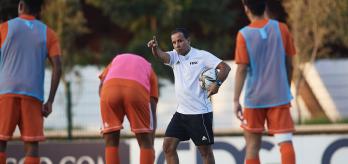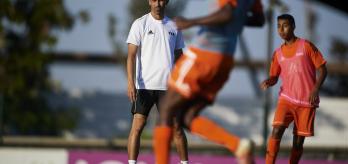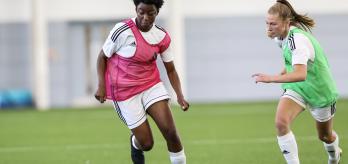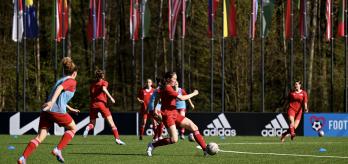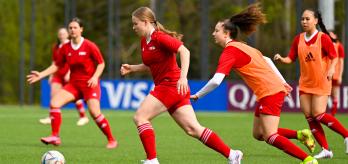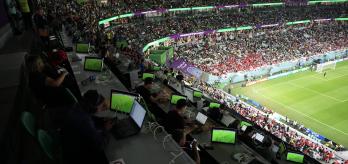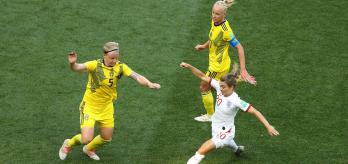Reacting quickly and pressing the ball-carrying player as soon as possession is lost significantly boosts a team’s chances of regaining possession within seconds and means that they are not susceptible to the opposition springing a quick counter-attack.
In this session, FIFA Technical Expert Anne Pochert delivers a series of exercises to a group of women that focus on counter-pressing. The session starts with players working on preventing the ball from being transferred from one zone to another after possession is lost. The final exercise is a 7v7 game in which the players are asked to put the counter-pressing principles acquired in the previous exercises into practice.
Session overview
Key coaching points
-
Press the ball-carrying player immediately to force them into a mistake caused by them not having had the chance to scan their passing options.
-
If the first pressing action is unsuccessful, ensure that passing lanes are closed off so that the ball can be intercepted.
-
Prevent passes from being played in behind the defence by squeezing up and limiting space or creating an offside trap.
-
Play with intensity to be prepared for, and react quickly to, a turnover of possession.
Introduction
Before the players take to the pitch to perform the exercises, it is a good idea to get them to think about all of the actions and strategies that they may need to call upon during the session to prepare and execute counter-pressing.
Part 1: 3v1 rondo in reduced playing area
The first exercise involves a rondo in which the pressing player is asked to apply immediate pressure on the ball-carrying player. This drill focuses on reaction times and the short movements required when counter-pressing.
-
Mark out two adjacent 5x5m playing areas.
-
Split the players into two groups, one per playing area.
-
Three players in each group form a rondo inside the playing area.
-
Place a cone 3m behind each of the playing areas.
-
Line all of the remaining players up behind the cone.
-
The two coaches take up a position between the playing areas.
-
The exercise starts with the coach playing the ball to one of the players in the rondo.
-
The players in the rondo pass the ball between each other.
-
They are limited to two touches.
-
A player positioned in the line behind the cone sprints into the centre of the rondo once the coach has played the ball in and tries to win the ball back or intercept it as quickly as possible.
-
If the ball is intercepted or goes out of play, the pressing player sprints out of the rondo and tags the next player in the line.
-
The sequence is then repeated.
-
Once the ball has been intercepted four times, the players switch roles.
-
Players must take two touches.
-
Players are limited to one touch.
-
Apply immediate pressure on the ball-carrying player and try to force an error.
-
Anticipate where passes will be played so as to give opposing players little time to take a second touch.
-
Press at high intensity and focus on each player’s pressure points (weak foot, etc.).
Part 2: 4v4+2
This exercise is designed to encourage frequent turnovers of possession. It aims for players to work on reacting quickly after their team lose the ball and to counter-press efficiently.
-
Mark out a 20x20m playing area.
-
Divide the playing area into quarters (four zones).
-
Split the group into three teams of 4 and one group of 2 (jokers).
-
Position two teams and the 2 jokers inside one of the zones.
-
Ask the third team to wait outside the playing area.
-
The exercise starts with the in-possession team trying to retain possession inside one zone.
-
The two jokers are available to the in-possession team to create a 6v4 situation.
-
The out-of-possession team try to win the ball back.
-
When their team are in possession, players are limited to two touches.
-
As soon as the ball is lost or intercepted, play progresses to a neighbouring zone (not a diagonal zone) through a pass or a player dribbling the ball.
-
The team that lose the ball must react quickly to prevent the in-possession team from progressing play into a neighbouring zone.
-
If a team win the ball back immediately after giving it away, play continues in the same zone.
-
A team are awarded a point for completing ten passes.
Variation 1
-
Players can only pass the ball into the next zone.
Variation 2
-
When a player takes two touches, the following player is limited to one touch.
-
When possession is lost, apply immediate pressure on the ball-carrying player to increase the chances of possession being recovered.
-
The player closest to the ball should apply the press to set the tone for their team-mates.
-
The in-possession team should adopt a rest-defence structure to ensure that passing lanes are closed off.
Part 3: 7+1 GK v. 7+2 GKs
The final exercise, which involves a real-game scenario, puts the counter-pressing principles acquired in the previous exercises into practice. Players are asked to immediately press the ball to prevent the opposition from launching quick counter-attacks.
-
Use one half of a full-size pitch.
-
Place a full-size goal at one end of the playing area.
-
Place two full-size goals at the other end of the playing area.
-
Place a goalkeeper in each of the three goals.
-
Use cones to mark out a line 15m from the goal line of the two goals.
-
Split the group into two teams of 7.
-
The offside rule applies in this exercise.
-
The exercise starts with one of the goalkeepers at the end of the playing area with two full-size goals playing the ball to an orange defender.
-
The oranges aim to build up play and score into the full-size goal.
-
The blue team aim to defend and try to win the ball.
-
If the blues win the ball, they try to score into one of the two full-size goals.
-
The blues can only score in the goal on the side of the playing area where they regained possession.
-
The blues can only shoot at goal once they have passed the line marked by the cones.
-
If the oranges reclaim possession quickly, they can attack the opposite goal one more time. If they fail to score in the second attack, the sequence is over and a new one begins, with play restarting with one of the 2 goalkeepers building play up from the back.
Variation 1
-
The oranges are only allowed to switch play once during the sequence.
Variation 2
-
The oranges cannot play the ball back to the goalkeepers.
-
The oranges must keep good distances between players to allow them to react quickly and efficiently to transitions.
-
Press the ball-carrying player immediately after possession is lost, as this is the ideal time to regain possession.
-
If it is not possible to immediately apply pressure on the ball-carrying player, then the aim must be to close off potential passing lanes, secure central areas and avoid counter-attacks being launched in behind the defence.
-
Be compact during the opposition’s build-up play, shutting off the central areas and pressing once the ball is moved forwards.





